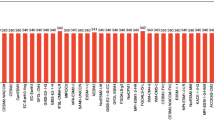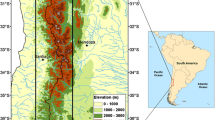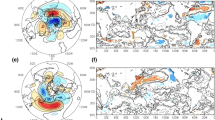Abstract
In this study, the global energy cycle of five state-of-the-art climate models is evaluated in the wave number domain for all seasons. The energy cycle estimates are based on 30 years of 6-hourly data obtained at pressure levels of all models. The models energetics are compared to those obtained from three reanalysis datasets (ERA-40, JRA-25 and NCEP-R2). The results show that the distributions of the energetics integrands and the shape of the various wave number spectra are reasonably well simulated. Many important features can be found in most models, namely both the upscale and downscale energy cascade for the wave–wave interactions of kinetic energy, the downscale energy cascade for the wave–wave interactions of available potential energy and the downscale energy transfer for the zonal–wave interactions of kinetic energy. However, the magnitude in the integrands distributions is generally excessive, yielding too much energy and an overactive energy cycle in the models. Accordingly, this energy excess is also reflected in the various spectra, specially but not exclusively, at the synoptic scale wave numbers for the energy conversion/transfer rates. The well known cold pole bias and the too strong tropospheric jets, along with their dislocation in some cases, still persist in the climate models. These are some of the deficiencies in the models directly implicated in the energy cycle. Apparently, simply increasing the horizontal and vertical resolutions is not enough to eliminate these deficiencies due to somewhat opposite effects achieved by refining both spatial resolutions. Therefore, more accurate physics parameterisations as well as improved numerical schemes and resolution dependence of parameterisations seem to be essential for a significant improvement in the models energetics. Moreover, efforts should be made to improve the physical processes controlling the generation of zonal available potential energy and dissipation of eddy kinetic energy, in which the synoptic scale should be fundamental, as inferred from the excessive energy conversion/transfer rates in the models spectra.

















Similar content being viewed by others
Abbreviations
- A Z , P(0):
-
Zonal available potential energy or total available potential energy in zonally averaged temperature distribution
- P(n):
-
Total available potential energy in eddies of wave number n
- A E :
-
Eddy available potential energy \(\left(=\!\sum_{n=1}^{N} P(n)\right)\)
- K Z , K(0):
-
Zonal kinetic energy or total kinetic energy in zonally averaged motion
- K(n):
-
Total kinetic energy in eddies of wave number n
- K E :
-
Eddy kinetic energy \(\left( =\!\sum_{n=1}^{N} K(n)\right)\)
- R(n):
-
Rate of transfer of zonal available potential energy to eddy available potential energy in wave number n
- C A :
-
Rate of transfer of A Z to A E \(\left( =\!\sum_{n=1}^{N} R(n)\right)\)
- S(n):
-
Rate of transfer of available potential energy to eddies of wave number n from eddies of all other wave numbers
- C Z , C(0):
-
Rate of conversion of zonal available potential energy to zonal kinetic energy
- C(n):
-
Rate of conversion of available potential energy of wave number n to eddy kinetic energy of wave number n
- C E :
-
Rate of conversion of A E to K E \(\left( =\!\sum_{n=1}^{N} C(n \right))\)
- M(n):
-
Rate of transfer of kinetic energy to the zonally averaged flow from eddies of wave number n
- C K :
-
Rate of transfer of K E to K Z \(\left( =\!\sum_{n=1}^{N} M(n)\right)\)
- L(n):
-
Rate of transfer of kinetic energy to eddies of wave number n from eddies of all other wave numbers
- G Z , G(0):
-
Rate of generation of zonal available potential energy due to the zonally averaged heating
- G(n):
-
Rate of generation of available potential energy of wave number n due to nonadiabatic heating
- G E :
-
Rate of generation of \(A_E \left( =\!\sum_{n=1}^{N} G(n)\right)\)
- D Z , D(0):
-
Rate of viscous dissipation of zonal kinetic energy
- D(n):
-
Rate of viscous dissipation of the kinetic energy of eddies of wave number n
- D E :
-
Rate of dissipation of \(K_E \left( =\!\sum_{n=1}^{N} D(n)\right)\)
- N :
-
Maximum wavenumber for the analysis (=72 in a 2.5 degree grid)
- a :
-
Mean earth radius
- c p :
-
Specific heat at constant pressure
- dm:
-
Element of mass
- g :
-
Acceleration of gravity
- h :
-
Diabatic heating rate
- i :
-
Square root of (−1)
- m, n:
-
Zonal wave numbers
- \({\mathcal{M}}\) :
-
Total mass of the atmosphere
- p :
-
Pressure
- R :
-
Dry air gas constant
- t :
-
Time
- T :
-
Temperature
- u :
-
Zonal wind
- v :
-
Meridional wind
- x :
-
Eastward viscous force per unit mass
- y :
-
Northward viscous force per unit mass
- Z :
-
Geopotential height
- α :
-
Specific volume
- ϕ :
-
Latitude
- γ :
-
Stability parameter
- λ :
-
Longitude
- θ :
-
Potential temperature
- ω :
-
Vertical p-velocity
- Φ :
-
Geopotential
References
Boer GJ, Denis B (1997) Numerical convergence of the dynamics of a GCM. Clim Dyn 13:359–374
Boer GJ, Lambert S (2008) The energy cycle in atmospheric models. Clim Dyn 30:371–390
Collins WD, Bitz CM, Blackmon ML, Bonan GB, Bretherton CS, Carton JA, Chang P, Doney SC, Hack JJ, Henderson TB, Kiehl JT, Large WG, McKenna DS, Santer BD, Smith RD (2006) The Community Climate System Model Version 3 (CCSM3). J Climate 19:2122–2143
Déqué M, Dreveton C, Braun A, Cariolle D (1994) The ARPEGE/IFS atmosphere model: a contribution to the french community climate modelling. Clim Dyn 10:249–266
Hamilton K, Wilson RJ, Hemler RS (1999) Middle atmosphere simulated with high vertical and horizontal resolution versions of a GCM: improvements in the cold pole bias and generation of a QBO-like oscillation in the tropics. J Atmos Sci 56:3829–3846
Hasegawa A, Tanaka HL, Hirakuchi H, Taguchi S (1997) Comparative energetics analysis of CCM2 with different horizontal resolutions. Clim Dyn 13:521–532
Held IM, Suarez MJ (1994) A proposal for the intercomparison of the dynamical cores of atmospheric general circulation models. Bull Am Meteorol Soc 75:1825–1830
Jones PW (1999) First- and second-order conservative remapping schemes for grids in spherical coordinates. Mon Wea Rev 127:2204–2210
Kanamitsu M, Ebisuzaki W, Woollen J, Yang SK, Hnilo JJ, Fiorino M, Potter GL (2002) NCEP-DOE AMIP-II reanalysis (R-2). Bull Amer Meteor Soc 83:1631–1643
Kung EC, Tanaka H (1983) Energetics analysis of the global circulation during the special observation periods of FGGE. J Atmos Sci 41:2575–2592
Kunz T, Fraedrich K, Kirk E (2008) Optimisation of simplified GCMs using circulation indices and maximum entropy production. Clim Dyn 30:803–813
Lindzen RL, Fox-Rabinovitz M (1989) Consistent vertical and horizontal resolution. Mon Wea Rev 11:2575–2583
Lorenz EN (1955) Available potential energy and the maintenance of the general circulation. Tellus 7:157–167
Marques CAF, Rocha A, Corte-Real J, Castanheira JM, Ferreira J, Melo-Gonçalves P (2009) Global atmospheric energetics from NCEP-Reanalysis 2 and ECMWF-ERA40 Reanalysis. Int J Climatol 29:159–174
McFarlane NA, Scinocca J, Lazare M, Harvey R, Verseghy D, Li J (2005) The CCCma third generation atmospheric general circulation model. CCCma internal rep., 25 pp
Nozawa T, Nagashima T, Shiogama H, Crooks SA (2005) Detecting natural influences on surface air temperature change in the early twentieth century. Geophys Res Lett 32(L20719)
Nozawa T, Nagashima T, Ogura T, Yokohata T, Okada N, Shiogama H (2007) Climate change simulations with a coupled ocean-atmosphere GCM called the model for interdisciplinary research on climate: MIROC. CGER’s Supercomputer Monograph Report 12, Center for Global Environmental Research, National Institute for Environmental Studies, Tsukuba, Japan, 79 pp
Onogi K, Tsutsui J, Koide H, Sakamoto M, Kobayashi S, Hatsushika H, Matsumoto T, Yamazaki N, Kamahori H, Takahashi K, Kadokura S, Wada K, Kato K, Oyama R, Ose T, Mannoji N, Taira R (2007) The JRA-25 reanalysis. J Meteor Soc Japan 85:369–432
Oort AH, Peixoto JP (1974) The annual cycle of the energetics of the atmosphere on a planetary scale. J Geophys Res 79:2705–2719
Peixoto JP, Oort AH (1992) Physics of climate. American Institute of Physics, New York
Pope VD, Stratton R (2002) The processes governing horizontal resolution sensitivity in a climate model. Clim Dyn 19:211–236
Pope VD, Pamment JA, Jackson DR, Slingo A (2001) The representation of water vapor and Its dependence on vertical resolution in the Hadley centre climate model. J Climate 14:3065–3085
Roeckner E, Bäuml G, Bonaventura L, Brokopf R, Esch M, Giorgetta M, Hagemann S, Kirchner I, Kornblueh L, Manzini E, Rhodin A, Schlese U, Schulzweida U, Tompkins A (2003) The atmospheric general circulation model ECHAM5. Part I: Model description. Max Planck Institute for Meteorology Rep. 349, 127 pp
Roeckner E, Brokopf R, Esch M, Giorgetta M, Hagemann S, Kornblueh L, Manzini L, Schlese U, Schulzweida U (2006) Sensitivity of simulated climate to horizontal and vertical resolution in the ECHAM5 atmosphere model. J Climate 19:3771–3791
Ruti PM, Rocco DD, Gualdi S (2006) Impact of increased vertical resolution on simulation of tropical climate. Theor Appl Climatol 85:61–80
Salas-Mélia D, Chauvin F, Déqué M, Douville H, Gueremy JF, Marquet P, Planton S, Royer JF, Tyteca S (2003) Description and validation of the CNRM-CM3 global coupled model. CNRM working note 103
Saltzman B (1957) Equations governing the energetics of the larger scales of atmospheric turbulence in the domain of wave number. J Meteor 14:513–523
Stratton R (1999) A high resolution AMIP integration using the Hadley Centre model HadAM2b. Clim Dyn 15:9–28
Stratton RA (2004) Report on aspects of variability in high-resolution versions of HadAM3. Hadley Centre technical note 53, 31 pp
Trenberth KE, Berry JC, Buja LE (1993) Vertical interpolation and truncation of model-coordinate data. NCAR Technical Note. NCAR/TN-396+STR, 54 pp
Uppala SM, Kållberg PW, Simmons AJ, Andrae U, da Costa Bechtold V, Fiorino M, Gibson J, Haseler J, Hernandez A, Kelly GA, Li X, Onogi K, Saarinen S, andR P Allan NS, Andersson E, Arpe K, Balmaseda MA, Beljaars ACM, van de Berg L, Bidlot J, Bormann N, Caires S, Chevallier F, Dethof A, Dragosavac M, Fisher M, Fuentes M, Hagemann S, H+lm E, Hoskins BJ, Isaksen L, Janssen PAEM, Jenne R, McNally AP, Mahfouf JF, Morcrette JJ, Rayner NA, Saunders RW, Simon P, Sterl A, Trenberth KE, Untch A, Vasiljevic D, Viterbo P, Woollen J (2005) The ERA-40 re-analysis. Q J R Meteorol Soc 131:2961–3012
Williamson DL, Kiehl JT, Hack JJ (1995) Climate sensitivity of the NCAR Community Climate Model (CCM2) to horizontal resolution. Clim Dyn 11:377–397
Acknowledgements
C. A. F. Marques was supported by the Portuguese Foundation for Science and Technology (FCT) under grant SFRH/BD/29341/2006. We are grateful to all the climate modelling Institutions mentioned in the text, for providing the atmospheric datasets used in this study.
Author information
Authors and Affiliations
Corresponding author
Appendix
Appendix
1.1 Operations on an arbitrary function f
-
Time average, \(\bar{f}:\)
$$ \bar{f} = {\frac{1} {t_2 - t_1}} \int\limits_{t_1}^{t_2} f \hbox{d}t, $$ -
Zonal average, [f]:
$$ \left[f\right] = {\frac{1} {2 \pi}} \int\limits_{0}^{2 \pi} f \hbox{d}\lambda, $$ -
Departure from zonal average, f *:
$$ f^{*} = f-\left[f\right] $$ -
Area average over an isobaric surface, \(\tilde{f}:\)
$$\tilde{f} = {\frac{1}{{4\pi }}}\int\limits_{0}^{{2\pi }} {\int\limits_{{ - {\frac{\pi }{2}}}}^{{{\frac{\pi }{2}}}} {f\,\cos \phi \,{\text{d}}\phi \,{\text{d}}\lambda } }$$ -
Departure from area average, f′′:
$$ f^{\prime\prime} = f-\tilde{f} $$
Fourier transform pair for harmonic analysis around latitude circles:
1.2 Expressions for the quantities in the balance Eqs. (1, 2, 3 and 4)
Rights and permissions
About this article
Cite this article
Marques, C.A.F., Rocha, A. & Corte-Real, J. Global diagnostic energetics of five state-of-the-art climate models. Clim Dyn 36, 1767–1794 (2011). https://doi.org/10.1007/s00382-010-0828-9
Received:
Accepted:
Published:
Issue Date:
DOI: https://doi.org/10.1007/s00382-010-0828-9




